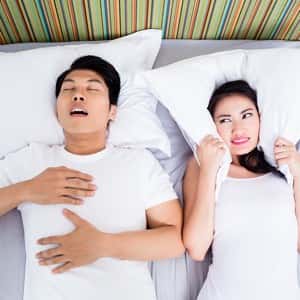
People go to great lengths to stop snoring. Some are silly, like sewing a tennis ball into the back of the pajama top. This is supposed to keep you from lying on your back, a position in which snoring is more likely.
Others are drastic, such as surgery to remove floppy tissue in the throat or the soft palate that vibrates during sleep.
A machine that provides continuous positive airway pressure (CPAP) is also prescribed for snoring. While this can be helpful, it can also be cumbersome and pricey. It may best be used for people who have sleep apnea, as it is an excellent treatment for that condition.
Finding an alternative approach that works can provide welcome relief for both the snorer and a bed partner. That’s why we appreciate this reader’s testimonial so much.
Acupressure to Stop Snoring:
Q. Ten years ago, I started snoring when sleeping on my back. It was not deep sleep apnea, but it would generally wake me up. Rolling over onto my side solved the problem.
Then I started snoring on my side as well, which pretty much ruined my sleep cycle. I searched your website for solutions and found a reference to using a wristband with a button to press on an acupressure point about three fingers up from the wrist joint.
That sounded goofy, but in desperation I tried it. I got immediate relief! I have essentially NO snoring now, and I’ve got my sleep cycle back.
Double-Purpose Acupressure Wristbands:
A. We’d almost forgotten about using acupressure wristbands to quiet snoring. These are the same wristbands that are used to prevent motion sickness; the acupressure point (“Inner Gate”) is between the two tendons on the inner wrist, three finger-widths above the joint.
We’ve not seen any research on acupressure to relieve snoring. There are, however, a number of studies on this technique for treating insomnia. Research suggests this nondrug approach can be helpful in adolescents (Neuropsychiatric Disease and Treatment, online Jan. 24, 2013); in geriatric patients with Alzheimer’s disease (Aging Clinical and Experimental Research, Feb., 2015); in menopausal women (Iranian Journal of Medical Science, July, 2015); and in heart patients in intensive care (Journal of Traditional and Complementary Medicine, Jan. 31, 2015). Since we don’t know of any side effects from this therapy, others may want to try this low-tech approach to snoring.
Acupressure Against Insomnia:
Another reader reminds everyone that acupressure on the Inner Gate point can help fight insomnia:
“Acupressure on the Inner Gate point also combats sleeplessness. Combining it with counting backwards and left nostril breathing has given me many nights of restful sleep.”

